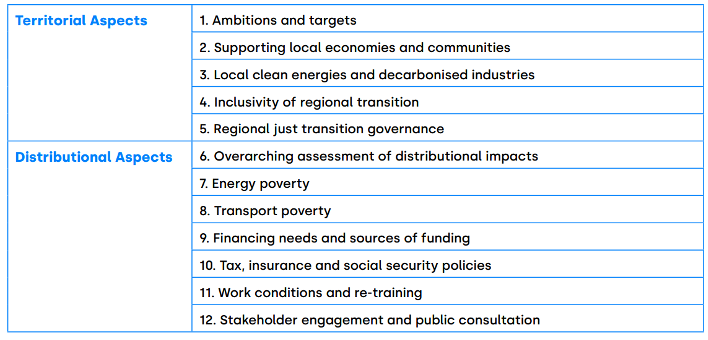National Energy and Climate Plans (NECP) represent an opportunity to combine climate and social objectives. Economically efficient and effective plans can foster a transition in line with a socially desirable, equal and resilient development, in compliance with the Earth’s planetary boundaries. The EU Commission’s general evaluation on the draft NECP delivered by the Italian government in July 2023 has been very clear as to what is the way forward: we need to adjust the Plan’s objectives, measures and policies if we want to stand up to the challenges ahead.
In ECCO’s analysis, published in December 2024, we put stress on those elements that undermine the effectiveness and the ambitiousness of the Italian NECP, with a particular attention to impact evaluation of socioeconomic values. This evidence was substantiated shortly afterwards by the above-mentioned Commission’s general evaluation. The latter highlighted how all Member States provided only a partial evaluation of the energy and climate transition’s socioeconomic impacts on people, families, and industries. This being a key element for the transition implementation. Furthermore, most of EU Plans lack specific policies to address negative impacts on society and employment that might stem from this transformation process. They further lack consistency with strategies and plans already in place, such as the Just Transition Plans.
Just Transition territorial and distributional aspects: Reform Institute-ECCO analysis
The Polish independent think tank Reform Institute, in partnership with ECCO, conducted an evaluation of two essential NECP just transition dimensions. The evaluation was structured through a list of criteria the NECP should comply with to foster a fair and just transition.

“Territorial Aspects” investigate whether there are tools within the Italian NECP capable of accompanying local communities through the transition process. The Polish think tank inquired about the existence of incentives for decarbonisation at local level. When found, they were measured on their ability to ensure an inclusive transition for the region and a governance structure for a just transition. Additionally, “Distributional Aspects” pointed out to criteria, which were able to catch differential impacts of climate policies on income and opportunities of different social groups (access to basic public services, access to job market, access to basic goods and rights) [1].
The overall analysis shows that according to some (but few) elements, Italy is on the right path to develop a better NECP compared to the one submitted in 2019. However, it is still mostly inadequate to achieve a territorial just transition and to acknowledge the costs and benefits distribution of planned sectorial measures.
Below some of the most relevant issues from the analysis:
Territorial Aspects
- Within Italian NECP, transition from fossil fuels seems to refer only to carbon, while there are plans to increase use of natural gas in some sectors. This undermines the country’s ability to reach climate neutrality targets.
- Lack of a clear governance structure undermines flow of information and synergies with other national and European Plans.
- Italian Just Transition Territorial Plans (JTTPs) contain essential measures to support local economies in vulnerable contexts, however, not all these measures are acknowledged within the 2023 Italian NECP.
- There are discrepancies between NECP and JTTPs objectives (i.e. the Plan concerning Sulcis Iglesiente), in particular, the year of planned carbon phase-out.
- Mapping of intervention areas is lacking, as well as an evaluation of territorial specific needs to increase access to and capacity of local clean energy systems and for the decarbonisation of local industrial processes.
Distributional Aspects
- There is a need for energy efficiency investment planning, strengthening local public transport systems and welfare policies to grant equal access to mobility for everyone.
- There is a lack of evaluation concerning the status of transport poverty in the country. There is also a lack of impact evaluation on vulnerable groups and sector employees regarding the transition away from combustion engine vehicles.
- Utter lack of policies and measures’ financial requirements and of available sources of financing. They further lack socioeconomic requirements.
- Lack of assessment on how fiscal, insurance and welfare policies will be deployed to support vulnerable groups.
Industrial policies and inequality: the floor to the experts
We have interviewed Prof. Andrea Roventini, Professor of political economy at Sant’Anna School of Advance Studies, and Prof. Maria Enrica Virgillito, Associate Professor of Economics at the Institute of Economics at Sant’Anna School of Advanced Studies. We wanted to understand in general terms what elements of the Italian NECP could affect social and territorial inequalities.
“Decarbonisation of the economy and the green transition, it’s an opportunity for development, growth and new employment”, states Roventini. He continues, “however, it is necessary for a government to introduce industrial policies to guide industries and the economy towards this process of transformation and decarbonisation. Therefore, the plan submitted by the Italian Government is utterly inadequate to put this transformation into action”.
According to Professor Maria Enrica Virgillito, “it is clear the lack of an industrial policy perspective, which should inform the whole Plan, rather than be informed by it”. Virgillito highlights “since there is no institution at ministerial level that can guide and plan national industrial policies, it is quite obvious how there can’t be an industrial policy framework within the NECP. The latter could represent a natural tool to planning the country manufacturing development, with decarbonisation strategic objectives”.
Concerning decarbonisation policies’ distributional impacts, Professor Roventini confirms that “in the absence of adequate policies, climate change and the ecological transition will fall on the least well-off members of the society”. Roventini highlights that “economic transformation will create more jobs than those that will be lost, however some sectors will suffer more than others. Consequently, there’ll be the need for moving workers within the job market and for their up-skilling and re-skilling (i.e. automobile sector). This means we need industrial policies to manage the transition and finance them through highest taxes to those responsible for higher greenhouse gas emissions”. Therefore, this transition could also be the “chance to reduce inequality, but it needs to be guided by policies”. Roventini concludes by saying that “the NECP should anticipate the public investments necessary for a set of industrial policies and for the economic transformation. If necessary, in the NECP we need to point at the financial coverage needed and a fiscal reform to provide the resources necessary to this transformation”.
Thinking about impact on territories, people, families and industries, Professor Virgillito highlights how “the just transition it’s not a specific objective of the Plan, although it is mentioned throughout the text. In order to be just and fair, the green transition needs to invest in three dimensions: employment, economic inequality and environmental inequalities”. Virgillito continues saying that we need to identify “left-behind places and develop place-based industrial policy strategies. This means repurposing obsolete manufacturing sites, in terms of technological deployment, management of the work force, health and safety in the workplace and environmental pollution ensuing from the process. If we consider that distribution of industries’ environmental hazards is not proportional and that those industries that pollute the most are those that also foster socioeconomic inequalities, repurpose and monitoring these sites should be the priority to guarantee new development paths for left-behind places”, Professor Virgillito concluded.
Recommendations: a fair plan for a just transition
Distributional aspects and socioeconomic impacts are considered within the NECP only through an input-output analysis and employment requirements. We now need to integrate these with further analysis and methodologies, some of which have been already tested and experimented with.
The Bank of Italy, for instance, provide a wide array of such tools in its studies. One example are the estimates on the Social Cost of Carbon (SCC), the latter used to evaluate costs and benefits of the National Resilience and Recovery Plan’s (NRRP) measures. In other works, concerning NRRP, they proposed an estimate of jobs created in those sectors affected by the Plan’s measures and a categorisation for required skills. They have done a similar analysis at regional level, looking at jobs created in the building sectors through building renovation. This kind of analysis is lacking within the NECP.
We would also need to map all co-benefits deriving from public investments in climate policies (i.e co-benefits from investments in public building energy efficiency renovations). We could also combine the above-mentioned cost-benefit analysis with indicators able to capture broad and indirect social impacts. Establishments such as the London School of Economics (LSE) and the European Investment Bank, conducted advanced studies on the implication of the use of indicators measuring social and environmental return on investments (Measuring impact beyond financial return (lse.ac.uk)). One of these indicators being the SROI (social return on investment), already mentioned in another ECCO’s work (page 28).
Setting up this kind of analysis now, to be ready for delivering the final NECP in June 2024, is a burdensome job. However, it is necessary to avoid wasting resources, to reach our climate and social targets and to ensure acceptability of the transition process.
Photo by Jahoo Clouseau
NOTE
[1] Further info on the analysis methodology in the Reform Institute documents linked below.







